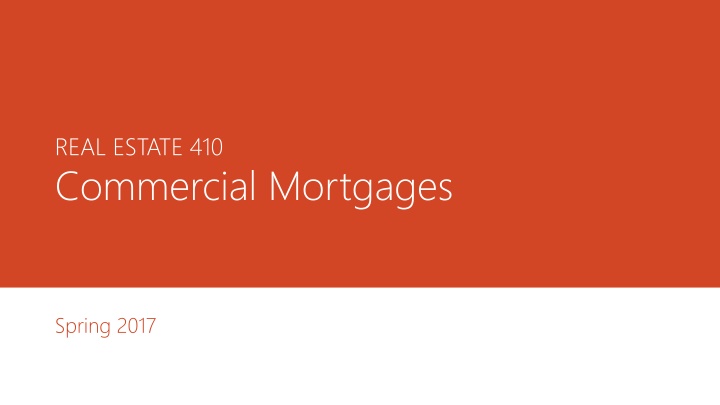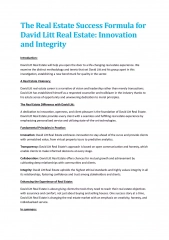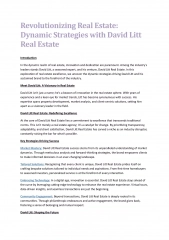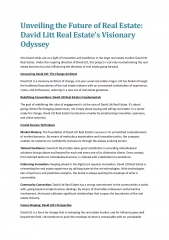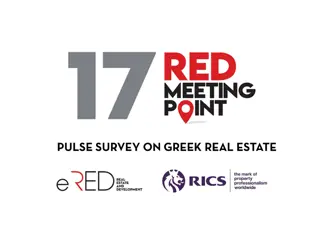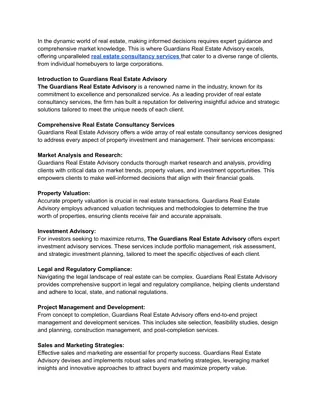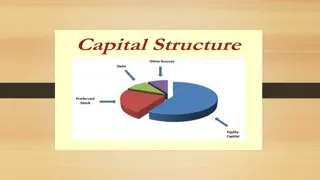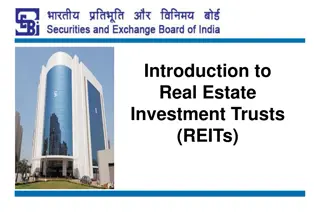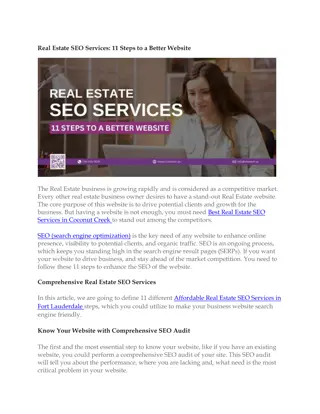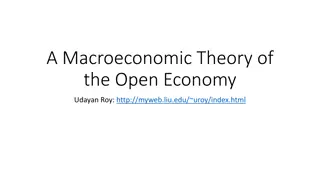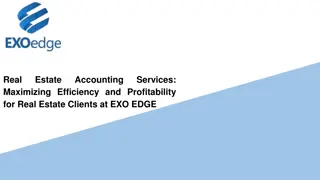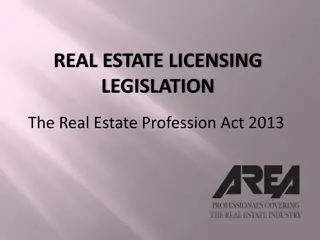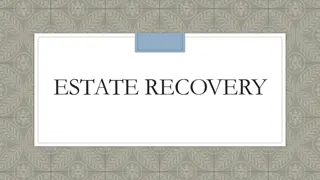Capital Structure in Real Estate Investment
Exploring the capital structure in real estate investments, this content delves into the various forms of capital used, advantages and disadvantages of debt for equity investors, and market frictions affecting capital choices. Understanding how capital structure impacts risk, returns, and decision-making can enhance investment strategies.
Download Presentation

Please find below an Image/Link to download the presentation.
The content on the website is provided AS IS for your information and personal use only. It may not be sold, licensed, or shared on other websites without obtaining consent from the author.If you encounter any issues during the download, it is possible that the publisher has removed the file from their server.
You are allowed to download the files provided on this website for personal or commercial use, subject to the condition that they are used lawfully. All files are the property of their respective owners.
The content on the website is provided AS IS for your information and personal use only. It may not be sold, licensed, or shared on other websites without obtaining consent from the author.
E N D
Presentation Transcript
REAL ESTATE 410 Commercial Mortgages Spring 2017
Topics Capital structure issues Commercial mortgage markets Characteristics of commercial mortgages Mortgages and risk allocation Bank vs. conduit CMBS loans Default and foreclosure Additional CRE topics 2
Capital Structure Various forms of capital used to finance real estate investments Equity, quasi equity (preferred equity), secured debt (1st-lien mortgages, 2nd mortgages, mezzanine debt), unsecured debt (debentures, working capital lines) Optimal capital structure depends on project, investors, investment vehicle, etc. Does capital structure matter? Depends on capital markets and whose perspective? For each provider of capital taken separately, the answer is an emphatic YEAH! For all providers of capital as a group NO under certain conditions (Modigliani and Miller (MM) (1958), Proposition I) MM does not say that capital structure is always irrelevant! Read last four sentences of conclusion 3
Capital Structure Market frictions assumed away by MM, 1958 Taxes Financial distress (bankruptcy) costs Transaction costs Agency costs Difference in borrowing cost between firms and investors Etc. 4
Debt Has Benefits Advantages of debt for equity investors Increased equity returns through leverage Move up on the security market line! Pursuit of additional positive-NPV projects (relax equity capital constraint) Decrease overall risk through diversification Lower agency costs through additional monitoring of management by debt market Agency problem between managers and equity investors Agency problem between minority and large equity investors (e.g., UPREIT structure) Strategic benefits 5
But They Come at a Cost Disadvantages of debt for equity investors Increases volatility of returns Amplifies equity returns both in good and bad times no free lunch! Increases cost of financial distress (bankruptcy costs) Limits ability to make strategic and tactical decisions as well as control over the assets Secured debt, particularly conduit (CMBS) mortgage loans, may limit ability of investor to redevelop and reposition property May decrease investment liquidity 6
Financing of CRE Panel A U.S. Mortgages Outstanding, 2011 $13.5 trillion, of which $3.1 trillion is CRE mortgages Panel B U.S. Institutional Commercial Real Estate Capital Structure, 2011 $4.1 trillion Panel C U.S. Commercial Mortgages Sources, 2011 $3.1 trillion outstanding 7
Market Segments Types of commercial loans Construction and permanent loans Primary market Where loans are originated Originators may maintain separate portfolio and conduit loan desks Secondary market Where mortgages are bought and sold by third parties Whole-loan market Commercial Mortgage-Backed Security (CMBS) market Collateralized Debt Obligation (CDO) markets for construction loans 8
Lender Self-Selection & Product Offering Construction Loans: Depositary institutions (banks and thrifts) Others (life insurance companies, conduits, mortgage REITs, etc.) Permanent Loans: Banks and thrifts Life insurance companies Pension funds CMBS Conduits GSEs Mortgage REITs 9
Loan Structures & Risk Characteristics Construction Loans Loan structure Risk characteristics Interest rate risk Little interest rate risk due to short duration Default risk (partly, refinancing risk) and loss recovery Significant due to supply lag. But there is some evidence that REITs have reduced the risk of oversupply Liquidity risk Less liquid than permanent loans 12
Loan Structures & Risk Characteristics Permanent Loans Loan structures Tailored to borrowers specific needs (structures can be quite complex) Risk Characteristics Interest rate risk Default risk and loss recovery Prepayment risk Significant prepayment protection Refinancing risk Significant due to balloon structure; depends on credit market conditions Liquidity risk Depend on the quality of the loan (property attributes) and business cycle, but more liquid than construction loans 13
Mortgage Calculations Mortgage amortization FRM, CPM, GPM, ARM, Negative amortization, etc. Yield and return calculations Contractual interest rate vs. YTM APR vs. YTM YTM vs. expected return Mortgage decisions Mortgage calculations 14
Loan Clauses and Covenants Exculpatory (non recourse) clause Bad-boy clause Credit enhancement Joint and several liability Acceleration clause Lender in possession clause Due-on-sale clause Lockout clause Prepayment clause Subordination clause Cross Default Lender s right to notice Borrower s right to reinstate Remember, no free lunch! Each clause is a mechanism shifting risk from one party to the other and is therefore reflected in the cost of the mortgage 15
Loan Clauses and Covenants Bad-Boy Clause Maintenance Risk shifting Most commercial mortgage are non-recourse, which may incite borrowers to misbehave Non-recourse implanted through a bankruptcy-remote structure SPV structure Tax considerations Accounting issues 16
Prepayments Prepayment of commercial mortgages Factors affecting prepayment Differences compared to home mortgages Lockout clause Most commercial mortgages prohibit against prepayment during a specified period of time (usually, the first 3 to 5 years), after which prepayment may be allowed with penalty Potential reasons 17
Common Prepayment Penalties Fixed percentage of loan balance Similar to home mortgage (about 2 - 4% of loan balance) Yield maintenance Borrower must pay lender PV of losses due to prepayment Defeasance penalty Borrower retires a mortgage loan using a set of U.S. Treasury securities producing equivalent cash flows (cost similar to maintenance yield) These penalties are meant to take away any potential benefits that borrowers may gain from a rate refinancing! 18
Mortgage Supply Largest suppliers of commercial mortgages Banks ($240 bn. in 2014); CMBS (conduit) market ($95 bn. in 2014, excl. GSEs) Debt outstanding 20
Bank vs. Conduit Loans Bank (Portfolio) Loans Conduit (CMBS) Loans 1. 2. 3. 4. 5. 6. 7. 8. Construction and permanent loans Flexible structure to fit borrower needs Higher rate Smaller loan amounts Recourse or non-recourse Assumable (conditional) Lockout period + prepayment penalty Renegotiation (easier) 1. 2. 3. 4. 5. 6. 7. 8. Mostly permanent loans Standardized structure Lower rate Large loan amounts; easier to securitized Usually non-recourse Assumable (conditional) Lockout period + prepayment penalty Renegotiation (more difficult) 21
Bank vs. Conduit Loans Cost should not be the only factor when deciding between a bank or conduit loan! The lower rates on conduit loans compensate borrowers for giving up the ability (option) to renegotiate the terms of the loans. Standardization also explains lower conduit loan rates. Choice between bank and conduit financing may not be always available Borrower may self-select between the bank-loan market and CMBS-conduit market, resulting in a separating equilibrium whereby some borrower type prefers bank loans and the other type chooses the conduit market. Arguments for and against? 22
Self-selection in Securitization CMBS conduit loan originators Commercial banks Conduit originators Insurance companies Self-selection in CMBS securitization by non-conduit loan originators, such as banks Factors affecting the decision of non-conduit originators to securitize commercial loans or keep them in portfolio as investment Are lenders more likely to securitize lower quality loans? 23
Default and Foreclosure No matter the quality of underwriting, loans do get distressed! What to do when a loan is distressed? Nonlitigious actions and workouts, if the documentation allows, because default and foreclosure are costly Important when deciding between bank and conduit channels But nonlitigious actions, such as forbearance, loan modification, and negotiated sales, involve a moral hazard Another potential challenge is determining the probability of default self-cure Foreclosure costs Significant. One reason why piling up debt on a property may not be optimal 24
Foreclosure Costs Loss severity rate: Ratio of expected losses if default takes place to outstanding loan balance Foreclosure loss severity rates typically range from 30 to 40% on commercial loans (Esaki, 2002), mostly due to: Lost interest and principal Legal costs Low foreclosure proceeds Lost revenues (Ciochetti and Shilling, 1999, foreclosure of CRE mortgage takes 12.6 months on average) Loss severity varies with the market cycle Effective underwriting considers both probability of default and expected loss severity Since the two are positively correlated, one would expect underwriting standards to be countercyclical What are the forces against this? 25
Monthly Distresses Monthly Additions and Reductions in Distress $60 $50 $40 $30 $20 $10 $0 -$10 -$20 -$30 -$40 1 2 3 4 1 2 3 4 1 2 3 4 1 2 3 4 1 2 3 4 1 2 3 4 1 2 3 4 1 2 3 '07 '08 '09 '10 '11 '12 '13 '14 Source: Real Capital Analytics 26
Credit and Solvency Risk Certain operating expenses and debt create formal obligations that are priority claims on available cash flow. E.g., property taxes, secured loans When cash flow is insufficient or nearly insufficient to fund the priority claims, financial distress can occur. Financial distress often necessitates restructuring obligations, liquidating assets, or both. This is often done under the supervision of the court. 27
Credit and Solvency Risk Negative Shock To Project Value Occurs No Default: Owner-Manager Pays P0 Restructure the Loan Default Manage the Asset In-House Foreclose Sell the Asset to an Outside Investor 28
Renegotiation Game When Narrow Self-Interest Rules No or low transaction costs: Foreclosure would likely dominate. It is the existence of foreclosure transaction costs that make the possibility of workout attractive (these costs include legal fees, regulatory capital costs, fire-sale discounts) With transaction costs, working out new mortgage terms at a cost that is less than the foreclosure cost alternative, the lender is better off. Moreover, the borrower is also better off, since she can continue with the mortgage at better terms than was previously the case. However, because the borrower knows that the lender would rather avoid the costs associated with foreclosure, the distressed borrower can threaten to default in order to extract more favorable mortgage terms than would be obtainable otherwise. In turn, the (forward-looking) lender knows that the borrower knows about the tendency toward workout, and prices this risk accordingly. 29
Why Liquidate Rather Than Restructure? Inefficient Borrower Illiquid Borrower Incentive Concerns: Borrower Underinvests or Gambles for Resurrection Establish a Reputation as a Tough Guy to Mitigate Strategic Default Priority or Conflicts with Respect to Other Debtholders Servicing Conflicts and Dis-Incentives to Restructure Insufficient Lender Capacity to Address Mod/Restructuring Complexities 30
Refinancing Decision Traditional approach Compare benefits to costs and choose wealth maximizing action Let s explore this through an example A $10 mn., 20-year FRM with a 8% interest rate and annual payments was issued 5 years ago with a 10-year maturity and 2% prepayment penalty. Should the borrower refinance now if 15-year loans with 5-year maturity are priced at 6%? Decision? What should the borrower do? 31
Global CRE Opportunities Cross-border investment activity has grown substantially as a result of increased international real estate allocations As noted, most future growth in property markets is expected to take place abroad in emerging economies But the US market is likely to remain strong in the near future See market reports in additional material folder 32
Global CRE Opportunities Investment (political) risk Business/operational risk Inflation risk Interest rate risk Currency risk Portfolio risk Financing Issues: Local vs. offshore borrowing local currency vs. foreign currency borrowing 33
CRE vs. Home Mortgages Commercial mortgages 1. Secured by 1st lien 2. Flexible loan structure 3. More expensive 4. Recourse or non-recourse 5. Assumable (with conditions) 6. Lockout period + prepayment penalty 7. Loan renegotiation easier for portfolio than securitized loans 8. Active secondary markets, but smaller portion securitized 9. No default guarantee for investors in securitized loans Home mortgages 1. Secured by 1st lien 2. Standardized loan structure 3. Less expensive 4. Agency loans non-recourse 5. Non assumable 6. Prepayment allowed for agency loans 7. Loan renegotiation easier for portfolio than securitized loans 8. Very active secondary market, large proportion securities 9. Default guarantee for investors in securitized agency loans 34
Primary Funding Sources Residential mortgages: Commercial banks Saving and loan associations Mutual saving banks Mortgage companies Commercial mortgages: Commercial banks Saving and loan associations Life insurance companies Pension funds LPs Mortgage REITs Hedge funds 35
Next: Mezzanine Finance 36
